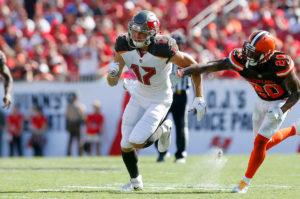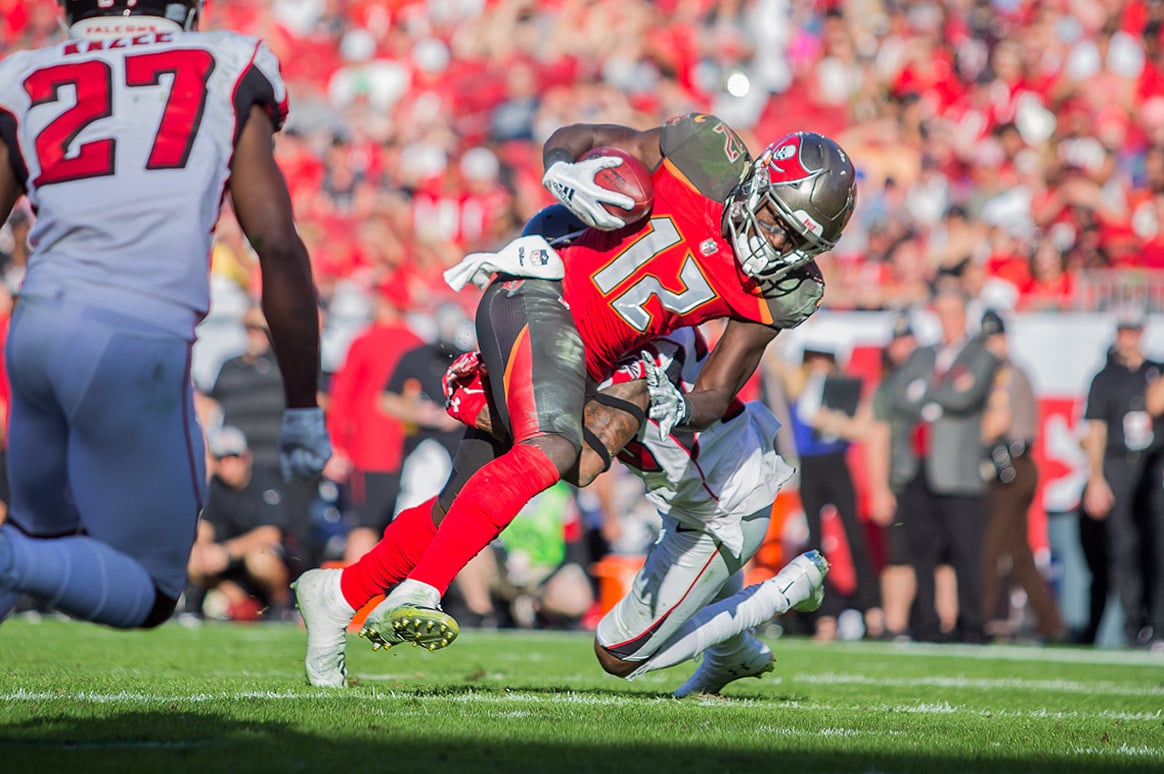FAB 2. Less Is More At WR For Bucs
There’s an old saying: “Sometimes less is more.”
While analyzing the Bucs’ reshaped wide receiver depth chart this offseason, I think that old saying really applies now that DeSean Jackson – and his malcontent attitude – is gone.
Jameis Winston never had to worry about getting the ball to Mike Evans, Chris Godwin or Adam Humphries. Evans never lobbied for the ball because he knew that the passing game was going through him. Godwin and Humphries are patient, soft-spoken, team-oriented guys to begin with, and never pressured Winston to get them the ball.
With Jackson on the team over the last two years it was different, and Winston knew it.

Bucs WR DeSean Jackson – Photo by: Getty Images
Jackson was getting paid $12.5 million in 2017 and $11 million last year. There was pressure to get such a highly paid receiver the ball. Winston felt it, and when he wasn’t feeling it, Jackson was there on the sidelines at times pitching a fit to remind him. Jackson pouted when he wasn’t getting the ball – or when the balls that were coming to him were overthrown.
Winston and Jackson never had chemistry, especially on the deep ball, which is where Jackson excels as a receiver. The reason is because Winston is not pin-point accurate on deep passes.
When Winston throws the deep ball to Evans or Godwin, he knows that both of those big receivers can go up and get it – often out-muscling or out-leaping a defensive back to do so. At the very least, Evans and Godwin would play defensive back and try to make sure that any errant pass wasn’t going to get picked off.
The 5-foot-10, 175-pound Jackson never did that. If the pass wasn’t on the money or overthrown, there was a decent chance the pass would get intercepted because Jackson would not fight for the ball. Winston has more success with receivers that have a bigger catch radius.
Humphries, who was Winston’s safety blanket underneath and on third down, is gone, and that won’t help the Bucs quarterback, who is entering a crucial fifth-year option year in 2019. The Bucs signed Breshad Perriman, a 6-foot-2, 212-pound target that has more size than Jackson or Humphries and offers Winston a deep threat with a bigger catch radius – provided he can catch it consistently.
The next receiver off the bench could be second-year receiver Justin Watson, who was last year’s fifth-round pick. At 6-foot-3, 215 pounds, Watson is another big receiver that could continue the rapport he developed with Winston in camp last year this offseason. At 6-foot-1, 209 pounds, Godwin is now the smallest of the Bucs’ top four receivers.
Winston doesn’t have to worry about feeding the ball to anyone this year. There’s no pressure to get the ball to a $10 million receiver, and more importantly no yappy dog on the sidelines being a nuisance barking his head off when he doesn’t get the ball.

Bucs WR Justin Watson – Photo by: Cliff Welch/PR
It’s true that Jackson and Humphries were the more accomplished receivers, but if Perriman and Watson can step up outside opposite Evans, and if Godwin can rule the middle in the slot, as expected, Winston and the Bucs will actually benefit from not having bigger name players on the roster – let alone more expensive ones as Jackson will be earning an average of $9.2 million in Philadelphia, and Humphries will be averaging $9 million in Tennessee.
The Bucs are hoping that less can be much more at wide receiver this year.
Scott Reynolds is in his 30th year of covering the Tampa Bay Buccaneers as the vice president, publisher and senior Bucs beat writer for PewterReport.com. Author of the popular SR's Fab 5 column on Fridays, Reynolds oversees web development and forges marketing partnerships for PewterReport.com in addition to his editorial duties. A graduate of Kansas State University in 1995, Reynolds spent six years giving back to the community as the defensive coordinator/defensive line coach for his sons' Pop Warner team, the South Pasco Predators. Reynolds can be reached at: [email protected]



